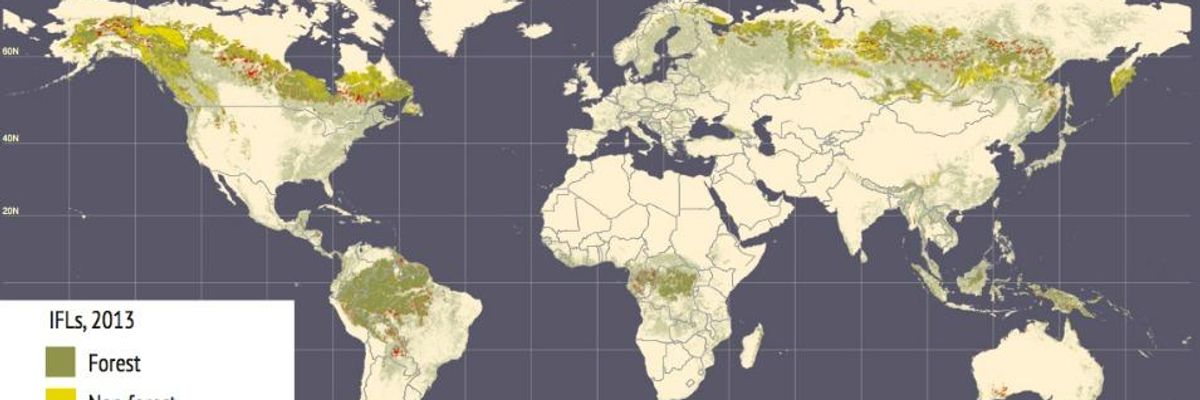

SUBSCRIBE TO OUR FREE NEWSLETTER
Daily news & progressive opinion—funded by the people, not the corporations—delivered straight to your inbox.
5
#000000
#FFFFFF
To donate by check, phone, or other method, see our More Ways to Give page.


Daily news & progressive opinion—funded by the people, not the corporations—delivered straight to your inbox.

(Image: Greenpeace)
The world's last remaining forest wildernesses are being damaged and destroyed by human activity at the shocking rate of 20,000 hectares--nearly 50,000 acres--per day, according to research findings announced Thursday.
Greenpeace, the University of Maryland, Transparent World, World Resources Institute, and World Wildlife Fund-Russia employed satellite imaging and mapping technology to chart out the global loss of Intact Forest Landscapes, which are unbroken areas of forest large enough to display biodiversity and bearing no damage from human logging, road construction, fossil fuel extraction, and more.
According to the groups, if something is not done to end the rate of destruction, these vital ecosystems could be wiped out completely before the end of next century.
The mapping done by the research found that a total area of IFLs three times the size of Germany was degraded between 2000 and 2013--amounting to over 8 percent of the world's undisturbed forests.
The largest areas of forest wilderness destruction taking place in the Northern Boreal forests of Canada, Russia and Alaska and tropical forests including the Amazon and Congo basins. Canada, Russia and Brazil are responsible for over 50 percent of this degradation, with extractive industries playing a critical role in the damage.
"There is an urgent need for governments to heed the calls of their citizens and to respect the rights of forest-dependent peoples by properly protecting remaining intact forests," said Dr. Nigel Sizer, Global Director of the Forest Program at WRI, and head of Global Forest Watch.
"Most of the degradation of intact forest landscapes is caused by fragmentation from roadbuilding, logging and clearing, meaning that we will lose these incredible landscapes and the forests that they contain if no action is taken to protect them," reads a Greenpeace statement about the findings.
Trump and Musk are on an unconstitutional rampage, aiming for virtually every corner of the federal government. These two right-wing billionaires are targeting nurses, scientists, teachers, daycare providers, judges, veterans, air traffic controllers, and nuclear safety inspectors. No one is safe. The food stamps program, Social Security, Medicare, and Medicaid are next. It’s an unprecedented disaster and a five-alarm fire, but there will be a reckoning. The people did not vote for this. The American people do not want this dystopian hellscape that hides behind claims of “efficiency.” Still, in reality, it is all a giveaway to corporate interests and the libertarian dreams of far-right oligarchs like Musk. Common Dreams is playing a vital role by reporting day and night on this orgy of corruption and greed, as well as what everyday people can do to organize and fight back. As a people-powered nonprofit news outlet, we cover issues the corporate media never will, but we can only continue with our readers’ support. |
The world's last remaining forest wildernesses are being damaged and destroyed by human activity at the shocking rate of 20,000 hectares--nearly 50,000 acres--per day, according to research findings announced Thursday.
Greenpeace, the University of Maryland, Transparent World, World Resources Institute, and World Wildlife Fund-Russia employed satellite imaging and mapping technology to chart out the global loss of Intact Forest Landscapes, which are unbroken areas of forest large enough to display biodiversity and bearing no damage from human logging, road construction, fossil fuel extraction, and more.
According to the groups, if something is not done to end the rate of destruction, these vital ecosystems could be wiped out completely before the end of next century.
The mapping done by the research found that a total area of IFLs three times the size of Germany was degraded between 2000 and 2013--amounting to over 8 percent of the world's undisturbed forests.
The largest areas of forest wilderness destruction taking place in the Northern Boreal forests of Canada, Russia and Alaska and tropical forests including the Amazon and Congo basins. Canada, Russia and Brazil are responsible for over 50 percent of this degradation, with extractive industries playing a critical role in the damage.
"There is an urgent need for governments to heed the calls of their citizens and to respect the rights of forest-dependent peoples by properly protecting remaining intact forests," said Dr. Nigel Sizer, Global Director of the Forest Program at WRI, and head of Global Forest Watch.
"Most of the degradation of intact forest landscapes is caused by fragmentation from roadbuilding, logging and clearing, meaning that we will lose these incredible landscapes and the forests that they contain if no action is taken to protect them," reads a Greenpeace statement about the findings.
The world's last remaining forest wildernesses are being damaged and destroyed by human activity at the shocking rate of 20,000 hectares--nearly 50,000 acres--per day, according to research findings announced Thursday.
Greenpeace, the University of Maryland, Transparent World, World Resources Institute, and World Wildlife Fund-Russia employed satellite imaging and mapping technology to chart out the global loss of Intact Forest Landscapes, which are unbroken areas of forest large enough to display biodiversity and bearing no damage from human logging, road construction, fossil fuel extraction, and more.
According to the groups, if something is not done to end the rate of destruction, these vital ecosystems could be wiped out completely before the end of next century.
The mapping done by the research found that a total area of IFLs three times the size of Germany was degraded between 2000 and 2013--amounting to over 8 percent of the world's undisturbed forests.
The largest areas of forest wilderness destruction taking place in the Northern Boreal forests of Canada, Russia and Alaska and tropical forests including the Amazon and Congo basins. Canada, Russia and Brazil are responsible for over 50 percent of this degradation, with extractive industries playing a critical role in the damage.
"There is an urgent need for governments to heed the calls of their citizens and to respect the rights of forest-dependent peoples by properly protecting remaining intact forests," said Dr. Nigel Sizer, Global Director of the Forest Program at WRI, and head of Global Forest Watch.
"Most of the degradation of intact forest landscapes is caused by fragmentation from roadbuilding, logging and clearing, meaning that we will lose these incredible landscapes and the forests that they contain if no action is taken to protect them," reads a Greenpeace statement about the findings.